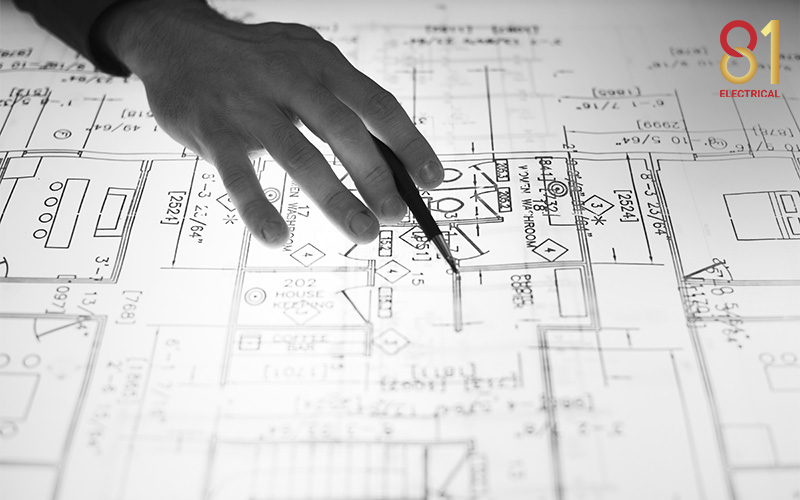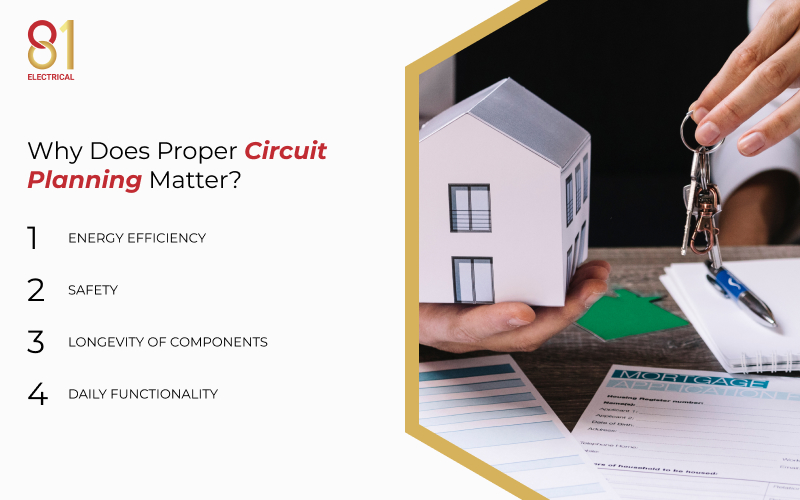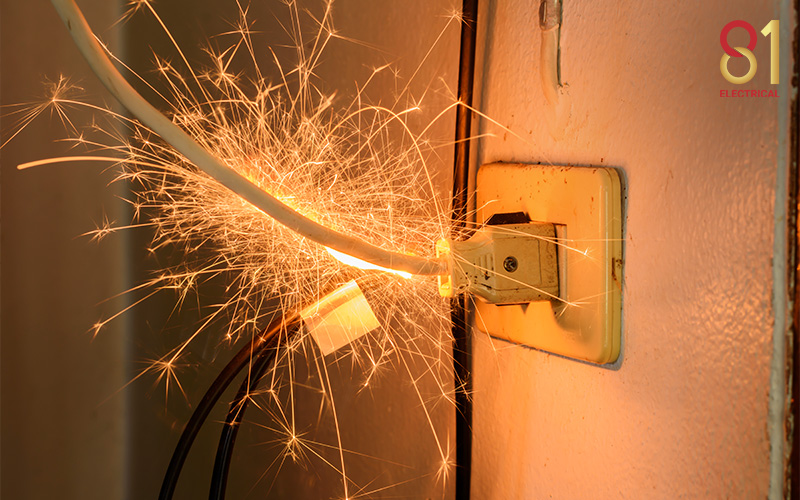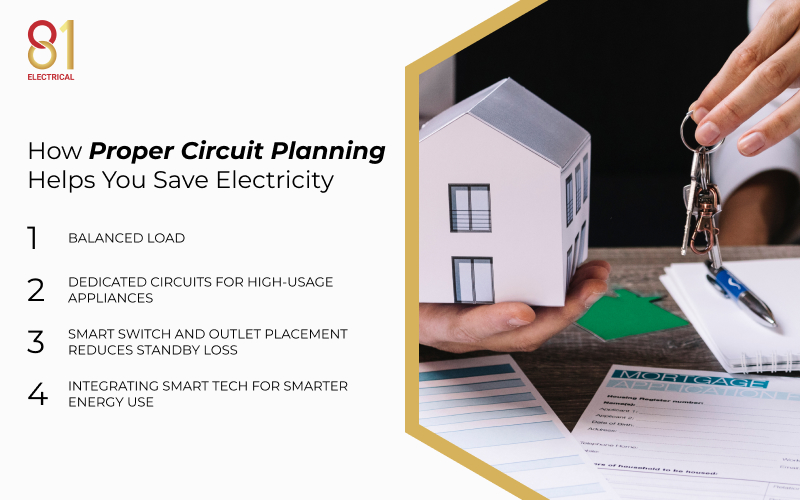Electricity Bills Too High? Save Electricity with Proper Circuit Planning
Introduction
If your electricity bill has been increasing month after month, you’re not imagining things. With rising utility rates, more time spent at home, and an increasing number of appliances and digital devices in daily use, households in Singapore are consuming more power than ever.
While simple measures like switching to LED lights or unplugging idle devices may help save a little electricity, they often don’t address the root cause. In many cases, the real culprit is hidden behind your walls: inefficient or poorly planned electrical circuits that affect how power is distributed and consumed throughout your home.
In this article, we identify how the design and distribution of your home’s electrical circuits can directly influence energy efficiency and your monthly expenses. You’ll discover the importance of strategic circuit planning in improving your safety and convenience, while helping you save electricity by reducing hidden wastage.
Key Takeaways
- Why Is Circuit Planning Important?
Circuit planning is the strategic design and layout of electrical circuits to ensure power is delivered safely, efficiently, and in a way that supports your usage needs. Done right, it not only improves safety and functionality but also helps you save electricity by reducing wasted energy and maintaining stable voltage.
- How Can Poor Circuit Planning Waste Electricity?
Overloaded circuits, shared heavy-duty and light-load appliances, phantom loads from always-on outlets, and excessive reliance on extension cords all contribute to hidden energy losses. These issues can drive up your electricity bills and put unnecessary strain on your electrical system.
- In What Ways Does Proper Circuit Planning Help You Save Electricity?
By balancing electrical loads, isolating high-usage appliances, positioning switches and outlets strategically, and integrating smart technology, proper circuit planning ensures your system runs efficiently. With reduced energy wastage, you’re saving electricity while keeping your appliances functioning efficiently and lasting longer.
- What Do Licensed Electricians in Singapore Recommend?
LEW-certified electricians advise conducting a load assessment before renovations, optimising your distribution board for zoned control, and future-proofing your system with extra capacity for upcoming technologies like EV chargers and home automation.
- How Can You Plan Your Circuits for Maximum Energy Efficiency?
Adopt zoning for lighting circuits, use isolated breakers for air-conditioning, avoid circuit crowding in the kitchen, and ensure enough dedicated outlets in bedrooms and home offices. These steps help you save electricity, improve safety, and maintain a reliable power supply.

Understanding Circuit Planning and Its Importance in Saving Electricity
What Is Circuit Planning?
Circuit planning is the process of strategically designing and laying out the electrical circuits within a home, office, or building. It determines the path electricity takes to reach appliances, lighting fixtures, and other systems, ensuring that power is safely delivered in a way that supports the needs of the space. A well-planned, dedicated power circuit layout is not only essential for safety but it also plays a part in saving electricity through optimised power flow.
What Does Circuit Planning Involve?
If you think proper circuit planning is only about wiring a home, you may want to think again. The process involves designing an electrical layout that strikes the right balance between safety, efficiency, and convenience. By carefully planning circuit divisions, strategically positioning switches and outlets, and balancing electrical loads, a well-designed circuit layout can optimise power usage. In the long run, this not only helps you save electricity but also keeps your utility bills in check.
1. Number of Circuits
Rather than having all appliances and systems draw power from a single circuit, loads are divided across multiple circuits. This prevents overloading, reduces strain on the wiring, and allows specific sections of your home to operate more efficiently.
For example, electrical contractors may separate high-consumption appliances like air conditioners or ovens onto dedicated circuits. These appliances draw a large amount of current when operating, which can cause voltage drops or fluctuations if they share a circuit with other devices. Such fluctuations may lead to inefficient operation or even tripped breakers. By assigning these heavy-load appliances to their own circuits, contractors ensure a stable power supply without affecting the performance of other devices.
2. Switch and Outlet Placement
Strategically placing switches and outlets helps improve both convenience and energy efficiency. Outlets located close to where appliances are used reduce the need for long extension cords, which can cause voltage drops and energy waste.
Similarly, strategically placed switches make it more convenient to turn off lights and devices when they’re not in use—a simple yet often overlooked way to save electricity. Over time, this encourages consistent energy-saving habits and helps reduce your electricity bills. For example, positioning switches near doorways or at key points in a room’s layout naturally prompts people to switch off appliances or lighting before leaving the space.
3. Load Distribution
Balancing the electrical load across different circuits ensures steady voltage levels and prevents sudden spikes in consumption. Uneven load distribution can cause certain circuits to draw more power than necessary, leading to wasted energy and higher utility bills.
By carefully balancing loads, a professional electrical company can design circuit plans that maintain consistent performance. This means no single circuit is overworked, reducing the likelihood of voltage fluctuations or sudden power surges that can strain appliances. Balanced loads also prevent inefficient energy draw, where appliances or lighting may use more power than necessary due to unstable voltage. An appropriate share of the electrical load thereby contributes to minimal energy waste and optimal system efficiency.

Why Does It Matter? Saving Electricity and Protecting Users
After exploring what circuit planning involves and how it works, it’s important to understand why it matters for your home or business. On top of powering your appliances, a well-designed electrical layout also helps you save electricity and ensures your day-to-day comfort.
Let’s explore how proper circuit planning delivers long-term benefits across these areas:

1. Energy Efficiency
A well-planned circuit layout ensures that appliances and lighting receive a stable, adequate supply of electricity. Poorly planned circuits, on the other hand, can cause appliances to work harder than necessary. As a result, they may draw more power to compensate for unstable voltage or competing loads. This not only wastes electricity but also increases your monthly utility bills.
2. Safety
Overloaded or unbalanced circuits can be dangerous because they force the wiring to carry more current than it’s designed to handle. This excess current flow generates heat, which can gradually damage insulation and other protective layers around the wires. If the temperature rises too high, it can cause the insulation to melt or ignite nearby flammable materials. In other words, this condition may turn a simple overload into a potential electrical fire. Proper circuit planning distributes loads evenly, reducing the risk of overheating and keeping your electrical system within safe operating limits.

3. Longevity of Components
When circuits run at an optimal load, they operate under less strain, which extends their lifespan. More importantly, this stability protects connected appliances from the damaging effects of voltage spikes, sudden drops, or overheating. In the long run, it requires fewer repairs and replacements, contributing to greater cost savings.
4. Daily Functionality
Good circuit planning also improves your day-to-day experience at home. Evenly distributed power prevents issues like dimming or flickering lights, slow-charging devices, and frequent tripping of circuit breakers. The result is a smoother electrical system that quietly works in the background, powering life’s little moments from brewing your morning coffee to keeping your home office running.
How Poor Circuit Planning Wastes Electricity
After understanding why circuit planning matters, it’s equally important to see how poor planning can quietly drain energy over time. Without well-planned circuit layouts and energy-efficient wiring, you may constantly encounter inconvenience and hidden power losses.
Below are some common ways bad circuit planning wastes electricity:
1. Overloaded Circuits Cause Energy Inefficiencies
When too many appliances share the same circuit, the electrical load can exceed what the circuit is designed to handle. This often results in voltage drops, forcing appliances to work harder and draw more electricity to perform their usual functions. Over time, this extra strain increases energy consumption and may even damage both the circuit and the connected devices.
2. Shared Circuits Create Energy Spikes
Placing heavy-duty appliances on the same circuit as lighting or smaller electronics creates uneven power flow. As large appliances draw high currents when starting or running, they cause sudden voltage fluctuations. These fluctuations make smaller devices work harder to stabilise their operation, leading to energy spikes, wasted electricity, and added stress on sensitive components.
3. Phantom Load from “Always-On” Outlets
A poorly planned electrical layout often leaves certain outlets constantly supplying power to unused devices. Items like routers, chargers, TVs, and printers in standby mode can draw electricity 24/7. This translates into a “phantom load” that slowly but steadily inflates your utility bills, even when the devices appear switched off.
4. Overuse of Extension Cords and Plug Multipliers
When a home lacks sufficient power points, reliance on multi-plug extensions and socket multipliers becomes the norm. In the context of electrical work in Singapore, this is a common sign that the home’s circuit layout or outlet distribution may not have been planned with modern appliance use in mind. Not only can this overreliance lead to safety risks from heat buildup, but it also causes unnecessary energy drain.
Saving Electricity With Proper Circuit Planning
How Proper Circuit Planning Helps You Save Electricity
A well-designed electrical layout can actively help you save electricity by ensuring that power is delivered to your appliances in the most efficient way possible. Instead of simply “making things work,” proper circuit planning focuses on reducing energy wastage at every stage.
In this section, we take a look at how thoughtful, smart electrical installation can support a more sustainable, energy-conscious lifestyle.

1. Balanced Load
Proper circuit planning ensures the electrical load is evenly distributed across all circuits. This balance maintains stable voltage levels, allowing appliances to operate at peak efficiency without drawing extra power to compensate for fluctuations. The result is less wasted energy, smoother performance, and reduced wear on your electrical system.
2. Dedicated Circuits for High-Usage Appliances
High-consumption appliances such as fridges, air conditioners, washing machines, and ovens should each be placed on their own dedicated circuit. This prevents them from interfering with other systems—like lighting or small electronics—reducing the risk of power surges and cutting down on unnecessary energy usage caused by voltage instability.
3. Smart Switch and Outlet Placement Reduces Standby Loss
Thoughtfully positioned outlets and switches make it easy to cut power to devices when they’re not in use. This helps eliminate the silent electricity drain that occurs when electronics remain plugged in but idle. Reducing this standby loss can help you save electricity in the long run.
4. Integrating Smart Tech for Smarter Energy Use
Incorporating dimmers, motion sensors, or smart switches during installation adds another layer of efficiency. These technologies automatically adjust power usage based on real-time needs. For example, dimming lights when natural daylight is sufficient or turning them off entirely when no one is in the room. Overall, smart electrical installations help to reduce waste without requiring constant manual intervention.
What Do Licensed Electricians Advise?
When it comes to circuit planning, licensed electricians in Singapore stress that the right approach can improve both safety and energy efficiency. Local homeowners can follow these recommendations to save electricity and ensure user protection.
1. Get a Load Assessment Before Renovation
Before you embark on any rewiring, renovation, or electrical upgrade, request a comprehensive load analysis from your electrician. This assessment reveals your home’s actual power demands, allowing circuits to be designed to handle both current and future usage efficiently. By planning for the right capacity upfront, you avoid overloading circuits and wasting electricity.

2. Hire Only LEW-Certified Electricians
In Singapore, any electrical work on HDB flats or major residential projects must be carried out by a Licensed Electrical Worker (LEW) approved by the Energy Market Authority (EMA). Working with an LEW ensures that installations meet strict safety and efficiency standards, giving you peace of mind that your electrical system is both compliant and optimised.
3. Ask About DB Board Optimisation
Your distribution board (DB box) is the nerve centre of your home’s electrical system. A well-organised DB layout supports zoned circuits, which not only makes fault isolation quicker but also allows you to control power more precisely. This zoning can improve energy efficiency. A simple example could be shutting off power to unused areas without affecting the rest of the home.
4. Use Circuit Planning to “Future-Proof” Your Home
During renovations or retrofits, plan circuits with extra capacity to support future needs, such as EV chargers, home automation systems, or additional appliances. This foresight prevents costly rewiring later and keeps your home adaptable, efficient, and ready for emerging technologies.
How to Plan for Energy Efficiency
If you want to save electricity in the long run, the key lies in how your home’s electrical circuits are designed from the start. From organising lighting into zones to dedicating circuits for high-consumption appliances, these strategies help you optimise energy use and keep appliances running efficiently.
1. Lighting Circuits: Plan by Zone
Organise your lighting into separate zones, such as the kitchen, living room, and hallways. By doing so, you only light up the spaces you’re actually using. This simple step reduces wasted electricity and makes it easier to manage lighting levels throughout the day.
2. Aircon Systems: Use Isolated Breakers
Air-conditioning units are among the most power-hungry appliances in Singapore homes. Placing them on dedicated breakers ensures stable operation, prevents overloads, and avoids performance issues in other appliances connected to the same system.

3. Kitchen Appliances: Avoid Circuit Crowding
Appliances like ovens, microwaves, and dishwashers each draw high amounts of power. When they share a circuit, voltage drops and energy spikes become more likely, leading to inefficiency and unnecessary wear. Dedicated circuits for each appliance ensure optimal performance and lower energy wastage.
4. Bedrooms and Home Offices: Install Enough Dedicated Outlets
Instead of relying heavily on extension cords or multi-plug adapters, engage a licensed power electrician to plan for ample socket points during installation. With enough well-positioned sockets, you can plug appliances directly into the wall, minimising energy loss and avoiding the potential hazards associated with makeshift power setups.
Frequently Asked Questions
1. What’s the difference between an overloaded and a balanced circuit?
An overloaded circuit draws more current than it’s designed to handle, leading to heat, inefficiency, or even tripping. A balanced circuit distributes the electrical load evenly, making appliances run more efficiently and safely. In the long run, it also helps you save electricity.
2. Should I rewire my HDB flat to save electricity?
If your flat is more than 20 years old or you experience frequent power trips, it may be time for electrical rewiring. Modern rewiring with load-optimised circuit planning can improve energy efficiency and safety.
3. Do I need a licensed electrician for circuit planning in Singapore?
Absolutely. Only a LEW-certified electrician is authorised to carry out or approve major electrical works, including rewiring and circuit planning, especially in HDB flats and commercial properties.
Conclusion
Proper circuit planning is one of the most effective ways to reduce electricity waste. By balancing electrical loads, isolating high-consumption appliances, and minimising standby power, you can save electricity while enhancing both safety and system efficiency. In addition, a well-planned electrical layout ensures stable voltage and prolongs the lifespan of your appliances for years to come.
Work with 81 Electrical for trusted electrical services in Singapore that keep your home or business future-ready. Our licensed and experienced electricians ensure your wiring meets all safety regulations and functions at peak efficiency. We also provide thorough periodic inspections and prompt rectifications, helping you maintain a reliable system and save electricity in the long term.
Contact us today for a quote.

